The LNER "standard" 61'6" buffet cars
If you thought that the history of the conversions in 1932-35 was complicated, so were the so-called "standard" 61'6" designs when they came along and the records are confusing. I'm sorry to keep making the point about the unreliability of records because all such stuff is man-made and liable to unrecorded progress and human error. They are not the proverbial tablets of stone which some people believe them to be.
Michael Harris covered the "standard" 61'6" design in his two books of 1975 and 1995 (reprinted in 2011) and so did Clive Carter in Back Track January 1995 (which also embraced all the conversions) so, to avoid duplication, I am going to focus on how it started, some grey areas and errors. There's long been a Kirk kit and now there's a RTR model from Hornby which I shall address obliquely by describing how the real thing looked.
This now breaks down into the following parts:
- The first 61'6" buffet cars - Production to D.167 launched - Gas or electric cooking? - Details and fittings - In BR days - Some models
The first 61'6" buffet cars
The first example of D.167 was built in 1933 in the middle of the period when shorter pre-Group carriages were being converted and for several years it was a one off and conversions continued to be made. Indeed, it was followed in 1934 by conversion of an LNER-built 61'6" carriage, to D.185. Here are the two Diagrams alongside each other:
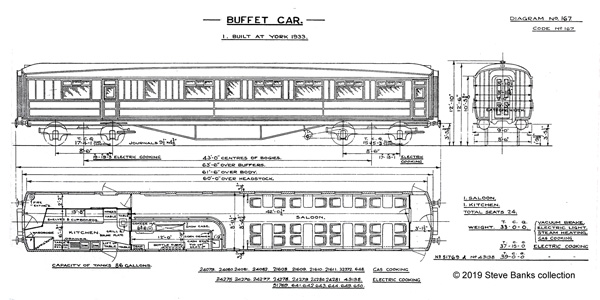
Click on the image for an enlargement
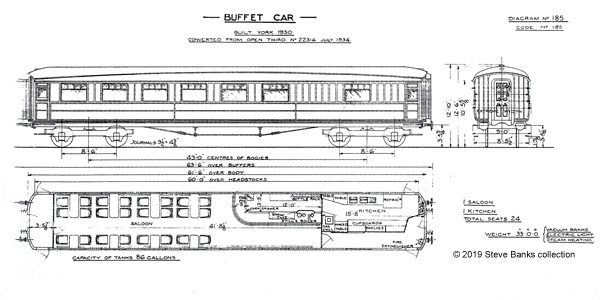
Click on the image for an enlargement
These developments have never been explained before. Internally, the two designs were very similar and they clearly embraced the same thinking. The main difference was in the provision of doors and windows in which regard the conversion was poorer by having fewer windows opposite the kitchen and bar and the external door was placed conventionally in the end vestibule. D.167 was more elegant with more windows and the entrance door at that end was placed further up the carriage and closer to the open/dining area. Both had cooking by gas. They were in fact a pair of prototypes.
In this period of conversions - when money was still tight - a custom-built buffet car may have been seen as unnecessarily expensive and Gresley wanted to explore the recently started concept that was proceeding well - of conversion from already extant carriages - but to the modern length. The one he chose was a D.27A 3rd Open dining car, albeit only built a few years ago, in 1930. The Diagram 27 series of dining cars (built to run with RFs) dated back to the first years after the Grouping and advanced through D.27/A/B/C as it became more modern - the same as all catering carriage designs for the best expresses. Gresley would have viewed the earlier ones as suitable candidates for replacement sooner or later and conversion to buffet cars would have been a viable option.
One also has to bear in mind that cost wasn't the only factor. When the LNER introduced buffet cars in 1932 it was feeling its way - indeed, the first two conversions were of carriages only 52'6" long. Once in service the LNER learned that they were so popular that it converted them back to TOs and went over to converting 58'6" designs instead. This was thwarted in the NE Area where nothing longer than 53'6" was available. As the LNER warmed to the concept and that buffet cars had as much PR value as restaurant cars, it seems that the desire to build elegant buffets increased and, for conversions, faded.
Production to D.167 launched
Hence conversion of pre-Grouping carriages ended in 1935 when the last two were produced and construction of brand-new RBs to D.167 kicked off as follows:
1935 - 7 1936 - 4 1937 - 15
Another mover in this sequence of events was the well-described keenness of the NEA to develop services with RBs. In other words, the years 1932-35 saw the tentative first steps and then the blossoming of buffet cars on the LNER.
Gas or electric cooking?
Michael Harris wrote that gas cooking was fitted until 1935 when it went electric, which implies that only the prototype had gas cooking. When he reproduced the Diagram for D.167, which Clive Carter also reproduced, it only referred to the prototype of 1933, No 32372. I happen to have a latter issue of that Diagram in which a lot more detail was added and by combining with other sources the following summary is possible:
1933 |
32372 |
gas |
light bogies |
1934 |
- |
- |
- |
1935 |
21608-11, 648 |
gas* |
light bogies |
1936 |
24079-82 |
electric |
heavy bogies |
1937 |
43138, 24275-81, 641-4, 649-50**, 51769 |
electric |
heavy bogies |
* Michael Harris described construction from 1935 having gone "all-electric". I don't know what his source was but the Diagram (above) and photo (below) show that gas continued to be used and the change didn't take place until 1936.
** In the Back Track article there is a typo and 649-50 are shown as having been built in "1935" instead of 1937.
1 - The first production batch
The LNER was proud of the new design and when Ogden's Cigarettes issued a new set of cards in 1936 titled "Modern Railways", the LNER allowed a water-colour picture to feature. This series was actually quite wide ranging and as you can see, the view inside a modern buffet car was very pleasing.
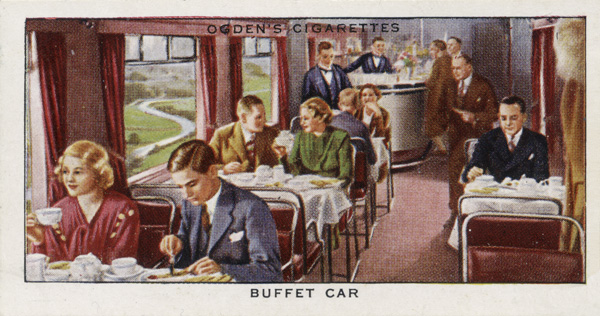
The picture is charming with the general layout showing well, the chromium-plated seats and the swish bar. Note the dark blue jackets worn by the staff.
But which Diagram was portrayed? The windows and toplights rule out all the conversions of pre-Grouping carriages and the three toplights point to the unique D.167 of 1933, No 32372. It was pretty much the last year of triple toplights which in new construction from around 1934 went to four-square. The only problem is that in the small window between the counter and the tables, the artist showed twin toplights, which are not shown on the Diagram nor in photos of subsequent cars to this Diagram where this window was plain and unventilated. Is it possible that 32372 did have twin toplights and the Diagram omitted them? Or perhaps the Diagram was correct and the artist made a mistake? It's impossible to say unless a picture of 32372 turns up. Author's collection.
Click on the image for an enlargement
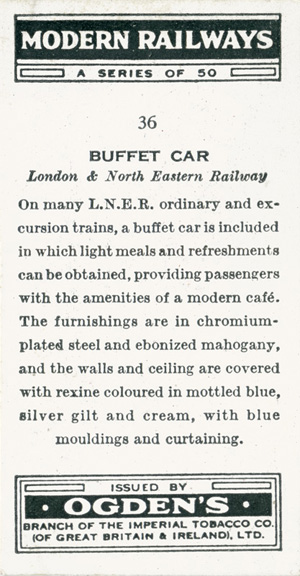
The back of the card. Dare I add that the description refers to blue rexine on the walls and blue curtains. Once again it's impossible to tell if that applied to the rest of D.167 but 32372 was different? Or that the artist wasn't quite right? He may have been working off a b&w photograph and guessed the colour?
Click on the image for an enlargement
2 - The second production batch - of 1936, I have three views of the same example:
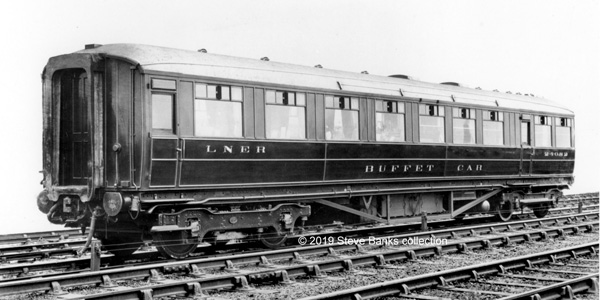
Click on the image for an enlargement
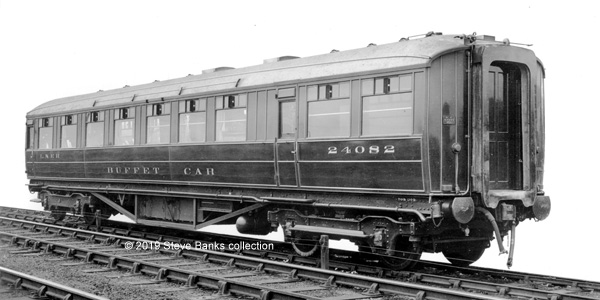
Click on the image for an enlargement
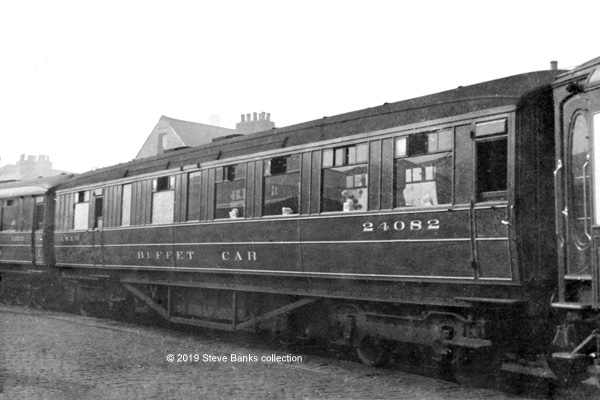
Click on the image for an enlargement
The two ex-works photographs show the corridor side of RB No 24082 from 1936 and the service picture, the kitchen side with the screened windows catching the light. All three views show electric cooking.
Bogies are the 8'6" heavy type which is not surprising given that most of D.167 with electric cooking was almost 5 tons heavier while two (Nos 43138 and 51769) were 6 tons heavier.
3 - The third production batch - of 1937 can be seen in the official view of No 24280:
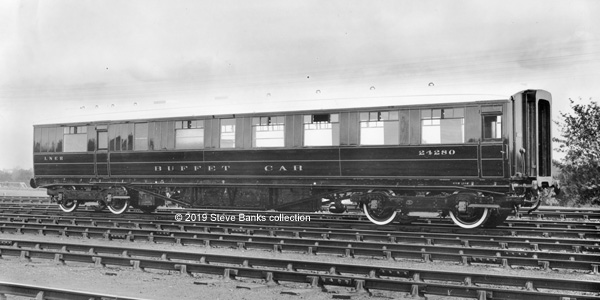
It too was fitted with electric cooking and heavy bogies. The screening of the catering windows appears to differ in intensity but was probably just the result of differing back lighting. Photo: Author's collection.
Click on the image for an enlargement
Summary of details and fittings
Body - the Diagram for D.167 shows toplights of the 3-rectangular type and it is possible that this was applied to the first one built in 1933 (32372), but all the photographs I have seen of subsequent builds show the later 4-square type.
Glazing - windows by the kitchen were screened pale white by the LNER (note that the Hornby model has clear textured glass as fitted to a preserved example on the SVR). The two windows on the corridor side opposite the kitchen were not screened in LNER days (that changed when BR applied screening).
Roof - two of the ex-works pictures show the buffet cars with a pristine roof in which most of the fittings are whited out but the others show the arrangements quite well. The key fitting was the pair of hard-to-describe rectangular vents which were a kind of double triangle with baffles on the outer ends which used the Venturi effect to create a draught. I described construction of these in the model article about about Gresley Kitchen Cars (note that the Hornby model has BR-fitted circular Vent-Axias).
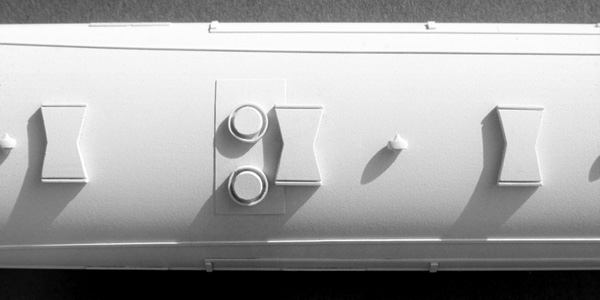
The best way I can illustrate the above is by showing how I approximated the fitting on a 4mm scale model of a Gresley Kitchen Car where several were fitted (the more powerful circular fans were directly over the ovens).
Underframe - See above re the type of cooking. There were extensive changes in BR days as the arrangements were modernised.
Bogies under the cars originally built 1933-35 with gas cooking were the light type. From 1936-37 when cooking was electric heavy bogies were fitted.
In BR days
The next group of pictures shows Gresley RBs to D.167 in BR days. I have about 15 of which one was captured in BR maroon livery and all the rest in blue & grey - people realised that they had become rare LNER survivors among the modern fleet and suddenly they were being photographed like mad! Rather than present them chronologically, I've set them out in numerical order, by the Thompson numbers which continued to be carried with an E suffix. Some went onto the Western Region where the "E" prefix was changed to a "W". Some also ran on the SR with an "S" prefix.
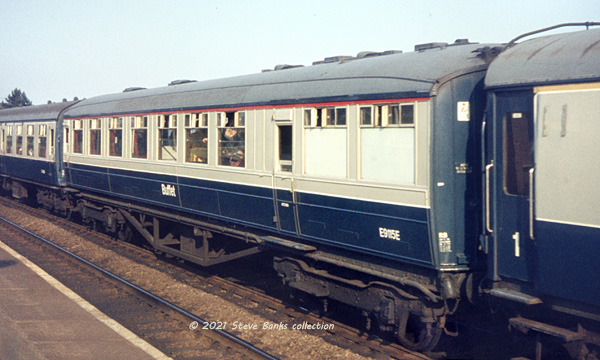
The location is not known but E9115E looks in fine condition. Note extension of rain deflectors over the two screened windows, possibly an addition if the toplights were persistently left open.
It had been built in 1936 for the NE Area as No 24079. Photo: Author's collection.
Click on the image for an enlargement

Captured on Saturday 7th September 1968 at Exeter St. Davids is W9118E (built in 1936 for the NE Area as No 24082). Seen from the corridor side with whited-out windows opposite the ktchen (unusually in this case the toplights as well) and the door branded "KITCHEN". These were changes from LNER practice when these windows were not screened and the door was treated as a public one.
Note that it has been placed outside the formation, which is the 15.20 Plymouth-Sheffield. In charge was D1005 Western Venturer. Photo: John H,. Bird.
Click on the image for an enlargement
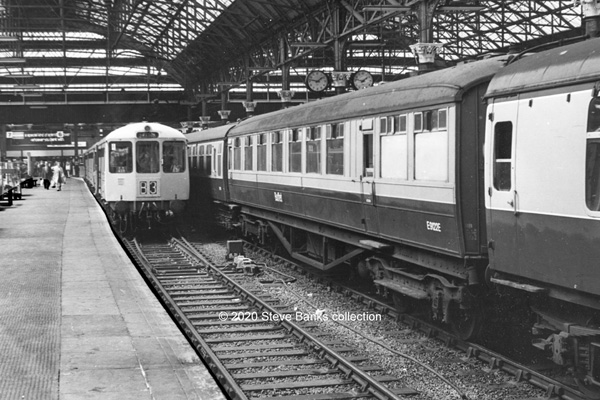
E9122E (built 1937 for the NEA as No 24278) stands at Manchester Piccadilly on Saturday 30th June 1973. In this case, and on all other pictures to hand, the toplights were not screened. It was captured inside the Manchester-Harwich service. By this time there were only three left in regular service. Happily, this one survived into preservation and now runs on the "GCR" line through Loughborough. Photo: D. Grifith.
Click on the image for an enlargement
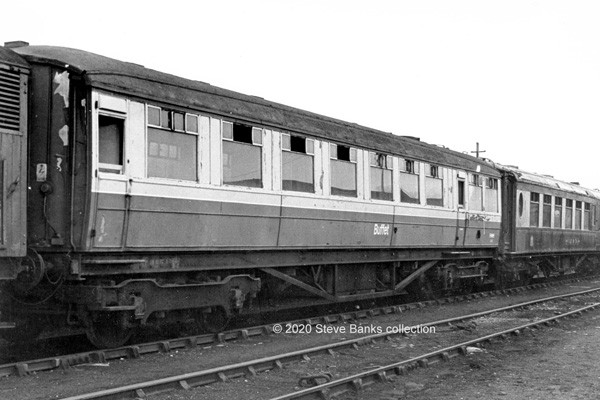
A sad sight at Swindon on 1st March 1979 is E9123 (another example built in 1936 for the NEA, numbered 24079) with the paint peeling off the teak. Yet this RB was saved and is currently owned by the Rushden Historical Transport Society. Photo: C. Burnham.
Click on the image for an enlargement
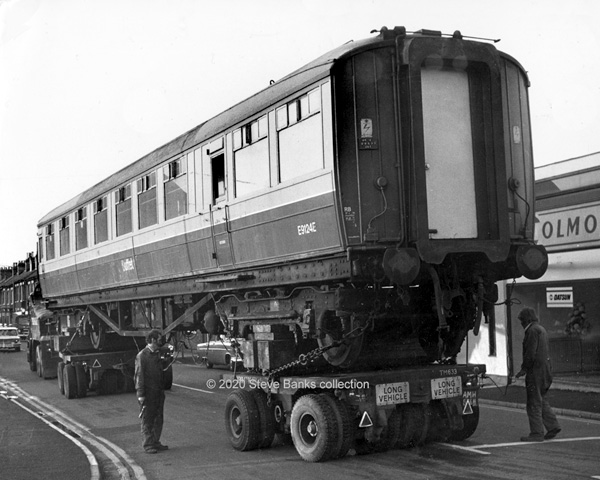
Another survivor, E9124E was also built in 1937 for the NEA as No 24280. It was photographed being manoeuvred into Ratcliffe Road in Loughborough on 10th November 1973. Photo: W.R. Squires.
Click on the image for an enlargement

E9128E was the only one built for the GC Section, in 1937 as No 51769. It was photographed on 5th April 1975 at Saltley in a "Preview Special" between Huddersfield-Portsmouth. This RB is preserved today on the North Norfolk Railway. Photo: Philip D.Hawkins.
Click on the image for an enlargement
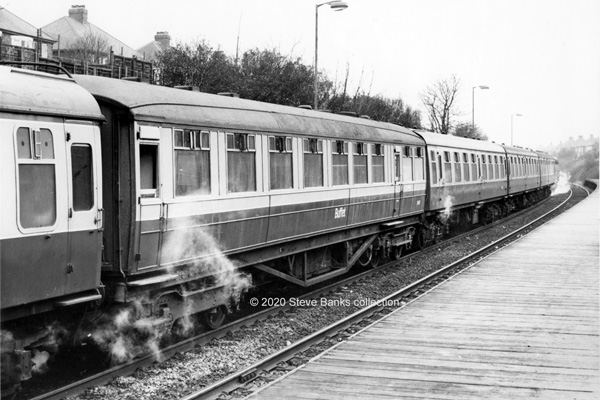
A fine picture at Seaburn on 6th March 1976 of a Gresley RB in a BR period excursion: a football charter from King's Cross carrying Crystal Palace fans (away to Sunderland in the FA Cup: 1-0 win for the London side)! Surrounded by BR Mk.1 2nd Opens is E9131E which had been built in 1937 for the GE Section as No 643. This example also survives, on the Severn Valley Railway (and was one of my personal first encounters; some things you never forget)! Photo: I.S. Carr.
Click on the image for an enlargement
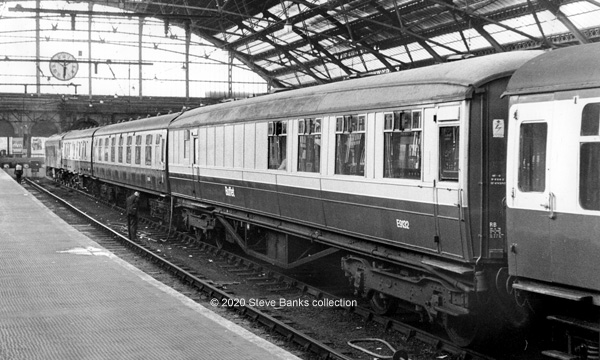
The next two pictures show the bar side on which windows were removed and the so-called "wooden wall" created. This is E9132 with no suffix (which had als been built for the GE Section, in 1937 as No 644).
It's serving in what used to be the 10am Newcastle-Liverpool with a restaurant car across the Pennines and now set off at 10.02, and is seen after arrival at Lime Street station on 14th January 1976. Note the sleek Mk.1 1st (FK) marshalled against the buffet car and that both are at the Liverpool station buffers end, with the customary BG at the outer end.
This buffet car is now on display at the NRM. Photo: B. Watkins.
Click on the image for an enlargement
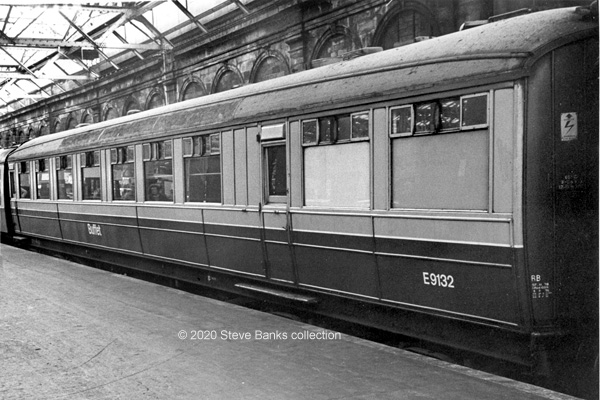
Another view of E9132 , taken on 18th October 1975 at Edinburgh in a special from Huddersfield. Note the variation in whiting out of the windows opposite the kitchen. Photo: G.A. Watt.
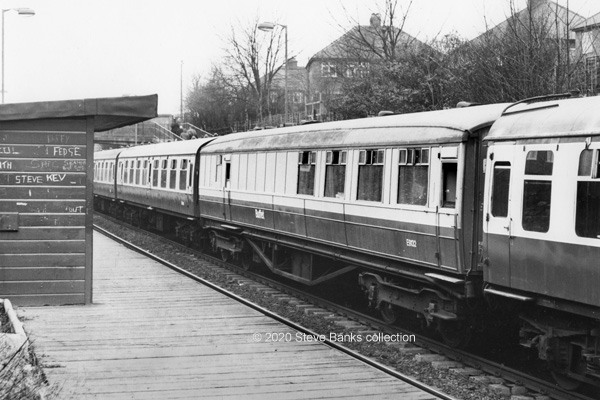
E9132, this time seen from the kitchen and bar side, on 6th March 1976 at Seaburn inside BR Mk.1 coaches with a football charter bringing Crystal Palace fans from King;s Cross for an FA Quarter Final at Sunderland. Alas for the travelling fans, it ended as a home win (1-0). This RB was also preserved. Photo: I.S. Carr (of Sunderland).
Click on the image for an enlargement
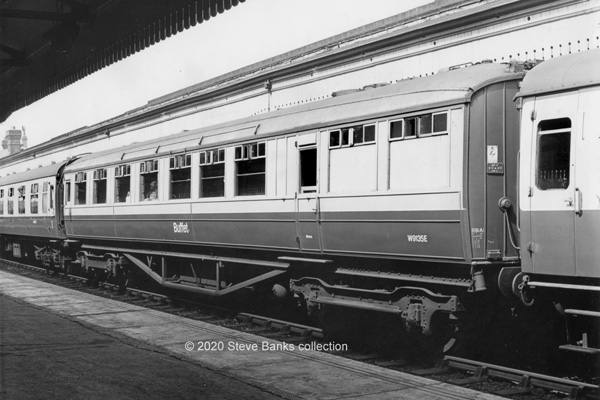
W9135E was also built in 1937 for the GE Section, as No 645, and became one of the long-lived buffet cars on the Western Region, and has been preserved. It is seen on 11th August 1968 at Salisbury looking very smart after a recent visit to the works inside the normally timetabled Cardiff-Portsmouth service in which it was marshalled alongside the 1st Class part of the train. The two whited-out windows were the same colour. Photo: Author's collection.
Click on the image for an enlargement
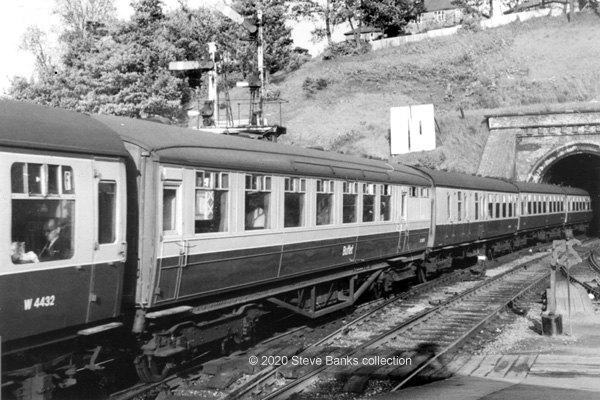
In ths view W9135E was captured in an excursion on 27th May 1972 from Weston-super-Mare-Norwich, about to enter Ipswich Tunnel with the return working. The Mk.1 formation is not very tidy with BSO alongside the RB.
Click on the image for an enlargement
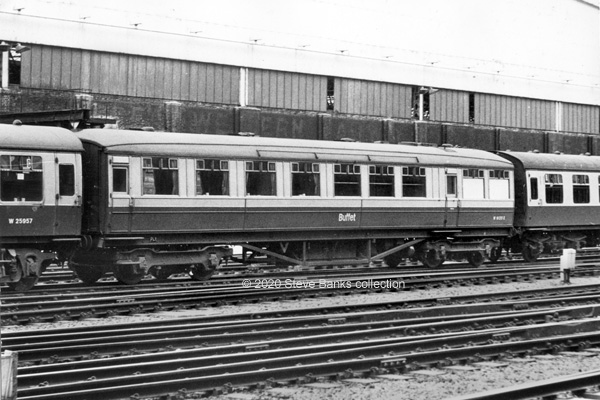
On 24th May 1975, W9135E was back in a normally timetabled express at Paddington bound for Plymouth. Note the PLY code on the solebar. Photo: Michael H.C. Baker.
Click on the image for an enlargement
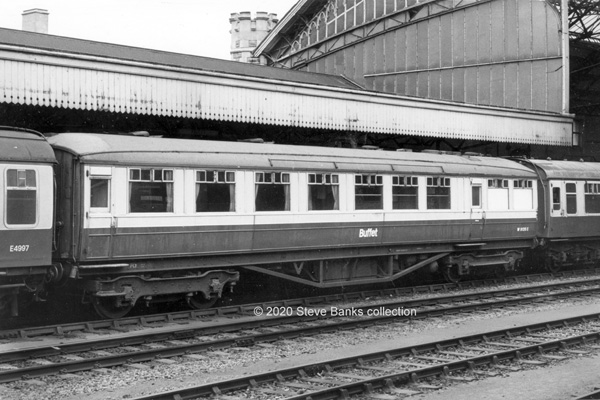
The following year, on 25th September 1976, W9135E was deployed in a football excursion from Weston-super-Mare to Liverpool. The location was Bristol Temple Meads. Photo: Roy Hounsell.
Click on the image for an enlargement
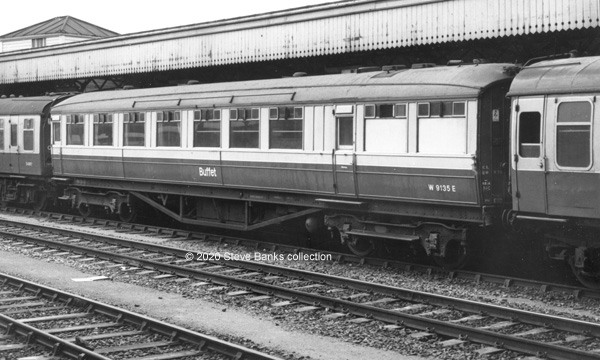
Another view looking in the opposite direction. Photo: Roy Hounsell.
Click on the image for an enlargement
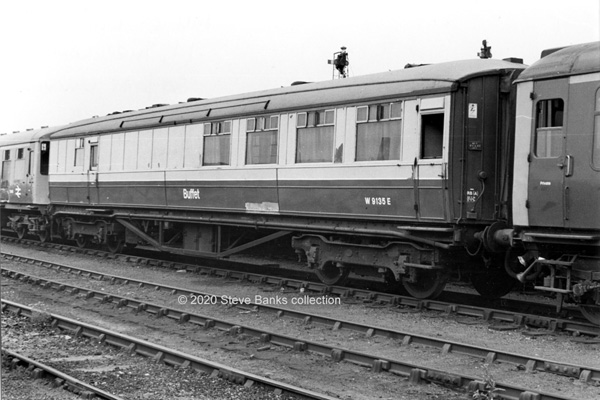
The final view of W9135E was taken in June 1977 at Doncaster after withdrawal. It has lost its shine but you can see the kitchen side and the small staff window. Photo: C. Burnham.
Click on the image for an enlargement
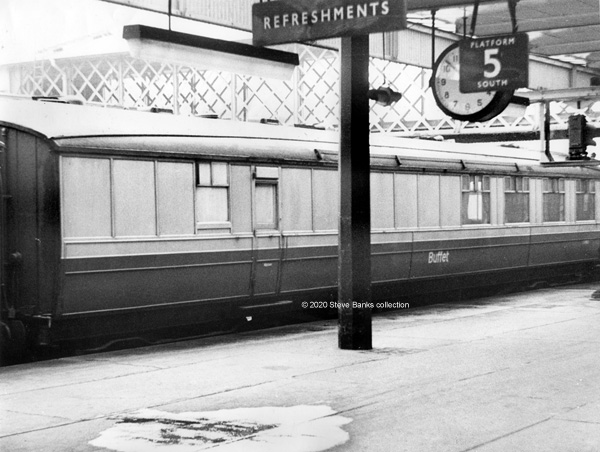
An unidentified location and an unidentified Gresley RB in BR blue and grey livery, the significance of this picture being that it's a fairly close view of the kitchen end with the reduced, half-window. There was no consistency re the opening toplight which, in this carriage, is the other way round compared with the other pictures. Photo: Author's collection.
Mike Whitchurch has identified the location as Platform 5 at Sheffield Midland (thank you)! It may have been in an excursion or the normal service "boat train" between Manchester-Parkeston Quay which was rostered for an "LNER vehicle" until 1976 and was one of the last general service uses of a Gresley RB. Another one at this time was between Paddington-Banbury which I used to see.
Alas its identity is still not known. A small number can be seen on the RHS but it's not legible. To my eye, the stand-out feature is the already mentioned left hand position of the sliding toplight in the reduced kitchen window - and a lower than usual lower panel which also has what may have been a strengthening piece added. None of the other pictures show this so, for now. I'm stuck!
In a reference to this picture on RMWeb it has been stated that the number of this carriage is "probably W9135E". It's an unsubstantiated guess and comparison of the reduced kitchen window with other photographs - specifically the handing of the sliding toplight and the shape of the lower panel - gets us no further except to rule out: E9132 W9135E
Click on the image for an enlargement
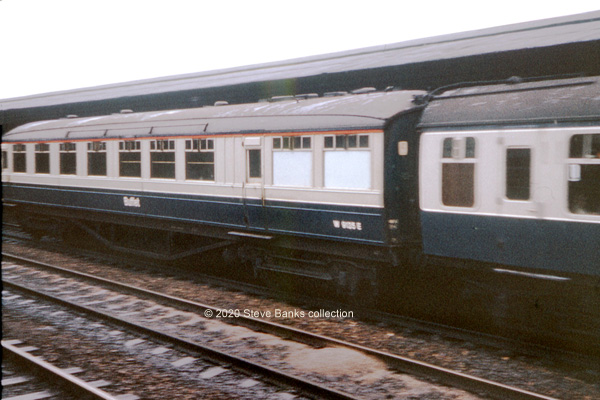
A rare colour picture, apparently taken with an Instamatic and under-exposed, dates from 1972 and shows a tidy Gresley RB No W9135E at Reading with a nicely clear red band under the roof signifying a catering vehicle. Note how it was marshalled outside the main train.
Part of the caption says "R.ROVER", which is beyond my ken. The slide is Kodak stamped "AUG 72" and the superb Six Bells Junction w/s doesn't show anything that might relate. Looking at individual excursions there was:
11-6-72 GWS Return to Steam with 7029 Clun Castle, which was steam hauled Didcot-Tyseley. But it's a guess on my part. Any ideas, anybody? Photo: Author's collection.
Click on the image for an enlargement
Some models
I can't offer proper constructional notes but these two examples do say a few things. Above all, that there is a learning curve for all of us.
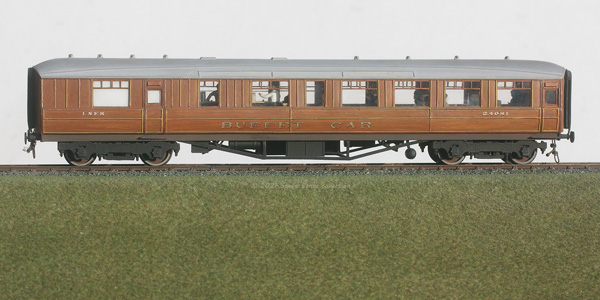
This model was scratch-built and one of my first forays in the hobby after settling down and getting married. Built on the living room table, I'd already built two PC kits and followed the same path but with scratch built sides and ends. Please don't be too critical, I was a young man and it was around 1975 when the only kits were PC (printed sides) and Phoenix (plain aluminium sides). This was the only way to get a model with proper beading, and note how slim it is! I had no idea how to make door and grab handles, hence their absence.
The trussing was scratch-built Plastikard with PC castings, including the bogies which turn out to have been the correct 8'6" heavy ones. Screw link couplings are a throwback to that era, before Kadee buckeyes came along, and a nightmare to couple up a train.
The livery was based on Humbrol's Authentic Railway Colours, GNR Wagon Brown, whose loss I felt keenly. It was the best colour for teak that I ever came across. Transfer were the original PC ones and thinner that they later became (when their slight over-size showed). The model still trundles round my layout in the loft.
Click on the image for an enlargement
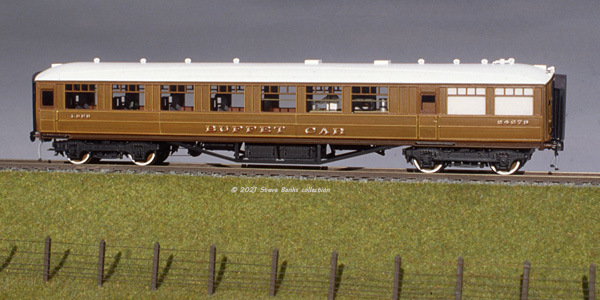
Things changed when the Kirk kits came long, and the MJT parts and this is what can be achieved. Actually, this is quite an early model, too, so you can see that the underframe is a bit simplified and the bogies are the wrong type (8'6" light). It was some years before I learned what was correct.
Click on the image for an enlargement


